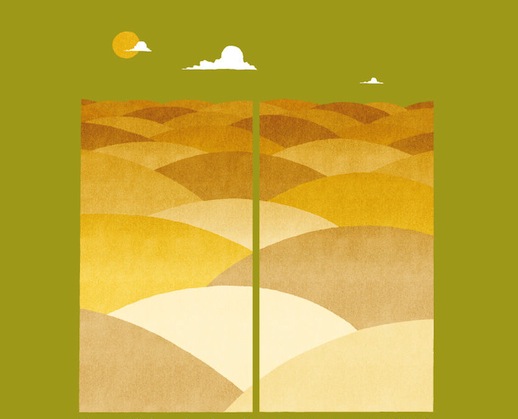by Rob St John
‘On the Chalk (Our Navigation of the Line of the Downs)’ is the fourth Memory Band record, recorded in an empty schoolroom in East London. It tracks the route of the Harrow Way, an ancient path intersecting Southern England, from the Straits of Dover to Dorset: a white line made by feet, wheels and hooves through the chalk bedrock. It is a route picked over – but rarely fully mapped or defined – by the research and imagination of generations of artists, historians and antiquarians. The Memory Band’s chief sonic cartographer Stephen Cracknell explains: ‘The idea with this record was for it to be a sonic road trip along a prehistoric trackway, an irreverent and episodic journey through a landscape inundated with history and the marks of change and transformation. Some of them are striking and immediate, others slow and imperceptible’.
Cracknell has spent a decade expanding and refining a distinctive sonic palette as The Memory Band, and whilst this ‘Abstractions of the Agricultural South’ (his phrase…) takes cues from library music experimentalist Basil Kirchin, the sound is distinct. High, brittle trickles of piano trip and fall over skittering, flitting drums: a shifting foundation of uncertain memory. Sampled voices are warped and layered like the stratified landscapes Cracknell explores, and syncopated Reichian rhythms tap a thread of movement: one foot following the other.
On ‘The Wearing Of The Horns (Weyhill On My Mind)’, the record emerges into being from a collage of radio static, environmental noise, and nameless narrators, clipping and tucking into a strident chant of ‘Horns, boys, horns! And die like his daddy with the long pair o’ horns.” over a burbling drone. The words are adapted from a song documented by writer George Bourne at the turn of the 20th century, recalling the entwinement of cattle horning and drinking rites at the Weyhill Fair in Hampshire.
As the track crackles into the distance, its dying squeaks could as easily be the chirrup of an upland bird as the turn of a wheel tracking along a path. On ‘Follow the Sarsen Stones’, kosmiche synths snake around ceremonial stabs of brass, a pageant song for the constellations of megalithic rocks and cracking concrete roads that litter the landscape. On the meditative piano-led burr of ‘What Blood is This?’, dislocated voices narrate ‘and then bombing started, and it all changed, everybody changed, it was different from what it is now’. This is a record where the pastoral meets the produced, where machines (whether cars, planes or drum machines) plough patterned furrows through rich and partially-obscured landscapes. As Cracknell puts it in the sleeve notes: ‘It is an album about change, the power of human will and our relationship with the landscape as we pass through it’.
There’s a great Gary Snyder poem called ‘Walking the New York Bedrock / Alive in a Sea of Information’, in which Snyder traverses Manhattan, imagining the city as a messy, interconnected ecosystem, where the natural and built environments blur and history reasserts itself:
Glass, aluminum, aggregate gravel,
Iron. Stainless steel.
Hollow honeycomb brain-buildings owned by
Columbia University, the landlord of
Anemone
colony
Alive, in the Sea of Information
There’s a resonance between the way that Snyder defines the landscape and the themes Cracknell explores in this record: on the Harrow Way dual carriageways jostle with burial mounds; the swollen muscle of railway lines flex around sarsen stones and old drove roads. Unlike a common thread of British folk music seeking to find authenticity in the songs and culture of some pre-industrial, bucolic time, this record arranges traditional songs to draw lines through the landscape from the past to the present; the real to the imagined. Hills and roads become the ribs and bones of a living ecosystem where self-willed stories weave resurgent threads through the chalk bedrock, tracked by this subtle, beautiful entwinement of traditional and modern song.
For more information on The Memory Band, click here. The album is available now from Rough Trade.
